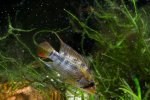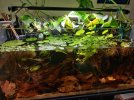Eddiekay1010
Member
- Messages
- 63
- Location
- United States
Hi, I've raised up a group of F1 macmasteri from fry and they are now a little over a year old. First time keeping this species, and was hoping for a little advice on breeding them. There are 3 in the group, and I believe I have a reverse trio, but not sure, worried that I may have 3 males, mainly due to the fact that the size difference between the dominant male and the suspected female isn't as drastic as I have come to expect with most Apistos. Another reason for my doubts is the fact that they have not spawned yet, but maybe there's a issue with my water parameters.
Temp-82
pH-6.77
GH-2
KH-1
Conductivity-68
50% weekly water changes with RODI, 90% RODI/ 10% waste water mix
Foods- frozen mysis shrimp, frozen bloodworms, frozen brine shrimp, live baby brine shrimp, flakes, bug bites, and also feed live blackworms when available
Confirmation on whether I have a female and any tips would be greatly appreciated, thanks so much!
Temp-82
pH-6.77
GH-2
KH-1
Conductivity-68
50% weekly water changes with RODI, 90% RODI/ 10% waste water mix
Foods- frozen mysis shrimp, frozen bloodworms, frozen brine shrimp, live baby brine shrimp, flakes, bug bites, and also feed live blackworms when available
Confirmation on whether I have a female and any tips would be greatly appreciated, thanks so much!


